
Lessons from the Trail | Part 3
By: Charlotte Staats - Adirondack Council's Clarence Petty Advocacy Intern
Tuesday, March 24, 2020
“Lessons from the Trail” is a blog series that discusses what the author, Charlotte Staats, has learned from living and working in the Adirondack Park. Charlotte Staats lives and recreates in the Adirondacks, and spent five seasons working on a backcountry trail crew that specializes in working in wilderness areas. The blog series will discuss her experience on trail crew, what she learned while working in backcountry settings, and the challenges she has seen facing the Adirondacks. Missed part one? Check it out HERE. Missed part two? Check it out HERE.
Inundated Trailheads
You might have read in the newspapers that the High Peaks and other popular, near-by mountains are facing scarring impacts from overuse. In the front country, trailheads are overwhelmed with visitors. On any given summer weekend, it is easy to drive along Route 73 and bear witness to the crowds eager to hike. I am happy so many people visit the Adirondacks and want to experience the special, natural beauty of the region.
However, when trailheads become as crowded and overcapacity as they are, it creates dangerous situations. I was relieved when I read that the state is beginning to address this issue, and is trying to solve this problem. There has been a small decrease in peak to the three most popular trailhead clusters in the region, but there has been a large increase in peak use at other trailheads that are nearby. All of these trailhead parking lots consistently are beyond capacity, and total annual use continues to grow. Beyond the trailhead, the magnitude of hikers is harming the trails themselves and impacting people’s wilderness experiences.
Being Loved to Death: Beyond the Trailhead
Even though you do not have to pay to recreate in the Adirondacks, there is still a price that is paid. The same trails that bring hikers to their favorite peaks or to the summit that offers the quintessential Adirondack snapshot are impacted by increasing erosion.
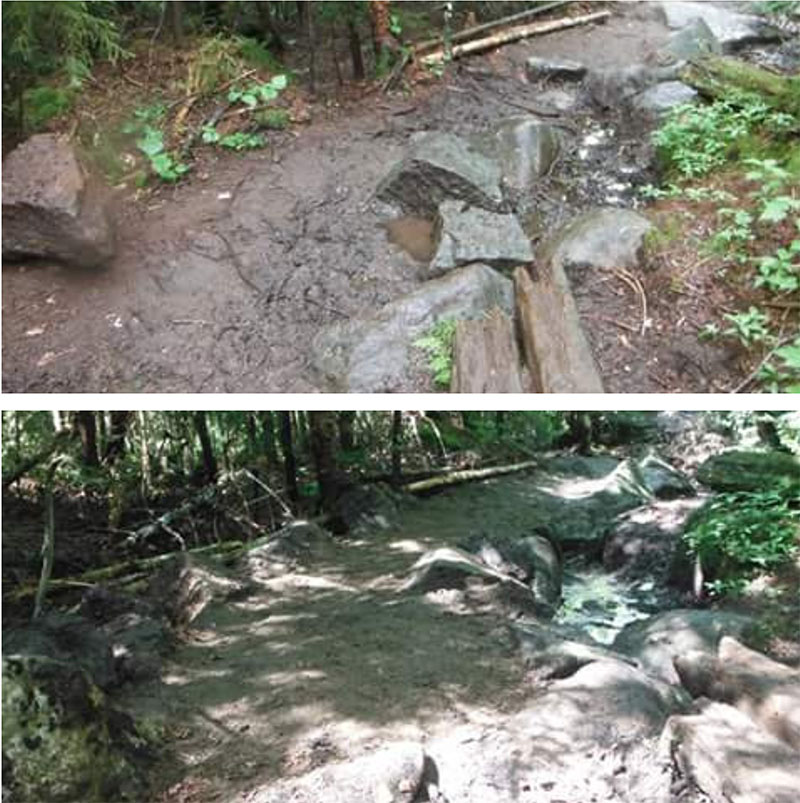 Top: Before the trail was muddy and had poor drainage. Hikers had started going off trail to avoid the mud.
Top: Before the trail was muddy and had poor drainage. Hikers had started going off trail to avoid the mud.
Bottom: After trail work, the same section of trail was raised and built to shed water off the trail.
Photo credit: Adeline Clayton
The first reason hiking trails are in trouble is poor trail design. Steep trails, delicate soils and poor drainage all contribute to the wear and tear of hiking trails. Adirondack hiking trails, particularly in the High Peaks, were not blazed with sustainability in mind but with a desire to get to the summits in the fastest way possible. This means trails often follow a fall line and go straight up a mountain. Trail designers today know that hiking straight up is not a sustainable way to create a trail. Still, Adirondack trails largely remain as they were built in the 1800s. As a result, there are more than 130 miles of trails in the High Peaks region that require serious amounts of trail reconstruction. And all trails require annual maintenance.
Erosion caused by poor trail design is compounded by soil compaction and erosion from footsteps, and there are thousands of boots hitting the trails in the High Peaks. The over-capacity trailheads are a testament to this. On peak weekends in the summer, popular peaks in the High Peaks have seen up to 500 people on the summit in one day.
There are a few ways footsteps negatively impact trails. The first that comes to mind is when there is a muddy or wet section of trail. In an effort to keep feet dry, hikers will skirt around the edges of the section to go around it. Over time, this makes the wet, muddy section grow. Ultimately, the section becomes too big to easily skirt around, and social herd paths are made completely off trail to avoid it. Not only is this a safety concern for those who use the social path and potentially get turned around, but it also spreads the impact of hiking outside of the designated trail. This results in trampled vegetation and further soil compaction. Hikers can also increase the zone of impact by going around steep sections of trail or large steps. When faced with these spots, people often choose the path of least resistance, and go around them, again spreading the impact off-trail. The last example that comes to mind is on the trail itself. Trails that are built on delicate soil cannot withstand the impact of boots and erode to become deep, gullied trails.
Trail crews exist to address these problems. The purpose of a trail crew is to improve and rehabilitate trails so that hikers stick to the designated trail, and so that the trails are protected from erosion and can withstand the footsteps of thousands of visitors perennially. In areas where a trail can and should be relocated, trail crews move the trail to a more sustainable location. This can mean anything from moving the trail to be on a more gradual slope or relocating it from a wet to dry location. Trail crews transform muddy, gullied out trails into well-drained hardened trails that can withstand the crowds coming to visit. Through improving drainage on a trail, water is shed faster and reduces the chances that a section of trail turns to mud. In areas where a hardened surface is needed, trail crews will use rock or wooden infrastructure to create a durable surface for people to hike on. Where there is good trail work, there is minimal impact on and around the trail.
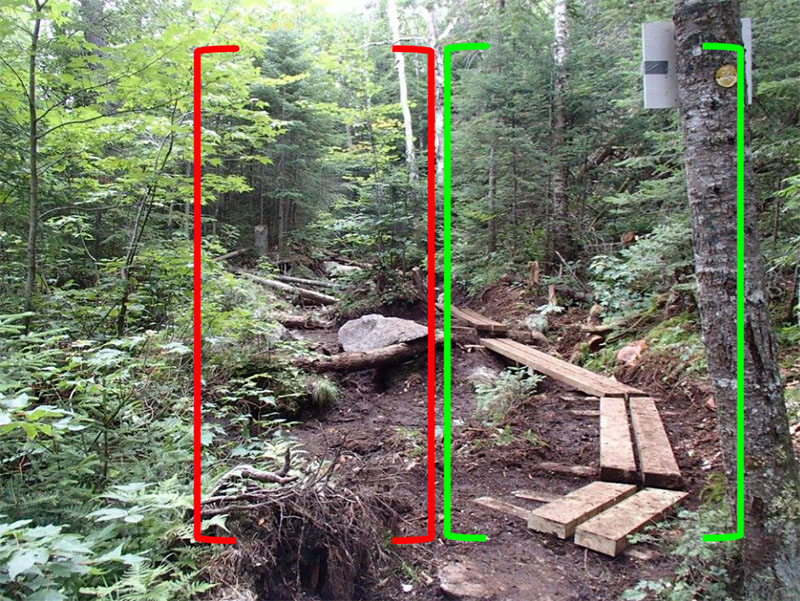 In the red parenthesis on the left, you can see where the old trail had been located. It had old, broken bridging, had gullied
In the red parenthesis on the left, you can see where the old trail had been located. It had old, broken bridging, had gullied
out and often turned into a stream when snow melted or a hard rainstorm came and flooded the area. In the green parenthesis
on the right, the trail had been relocated and built with new bog bridging to avoid the seasonal stream bed.
Photo credit: Alisa Fersch
Projects I worked on were typically located on sections of trail that lead to popular peaks. Popular trails face the worst erosion and impact and require constant maintenance to mitigate erosion. Even when maintenance efforts are focused on the hardest-hit trails, the problems on sections of trails we don’t get a chance to work on become worse.
Prior to our work on the trail to Avalanche Lake, there were knee-deep mud puddles, sections that turned into stream beds with any rain and gullied out trails. That isn’t to say all of the problems of that trail are fixed, but we improved a good portion of them. Before our crews worked on the backside of Mount Colden, there were steep slabs of bedrock whose trail had become up to five feet wide from hikers clinging to trees for stabilization. This summer we rebuilt cairns on the summits of Skylight and Haystack to ensure hikers recognized where the trail is and avoid stepping on fragile alpine vegetation.
In the 40-year history of the ADK’s professional trail crew, crews have worked to maintain the trails up Mount Marcy, Algonquin Peak, and Gothics, just to name a few. This is all to say, many of the trails in the Adirondacks have required maintenance in the past. Taking into account that an estimated 12.4 million people visit the Park annually, and more people are coming each year, the hiking trails in the Adirondacks are going to require even more trail work than ever before.
Not Gone but Mostly Forgotten
Meanwhile, other trails outside of the High Peaks are suffering from under use. Trails painstakingly made so that others could enjoy the ponds, rivers and smaller mountains of the region are slowly being reclaimed by the forest. Tracts of pristine wilderness regions with smaller mountains and more water are left in the dust -- passed by many, the secret retreat of a dedicated few. The Ha-De-Ron-Dah Wilderness, Pigeon Lake Wilderness and West Canada Lake Wilderness areas are just a few that see significantly fewer visitors. In fact, there aren’t enough visitors hiking to keep the trails looking like trails! Instead of building rock staircases and bog bridging in these regions, trail maintenance is most often focused on making sure the trail looks like a trail: free of plants, branches, blowdown and other obstacles that might hinder someone from being able to hike along a trail. This kind of trail work, called side-cutting, is essential in keeping these under-used trails open and easy to follow.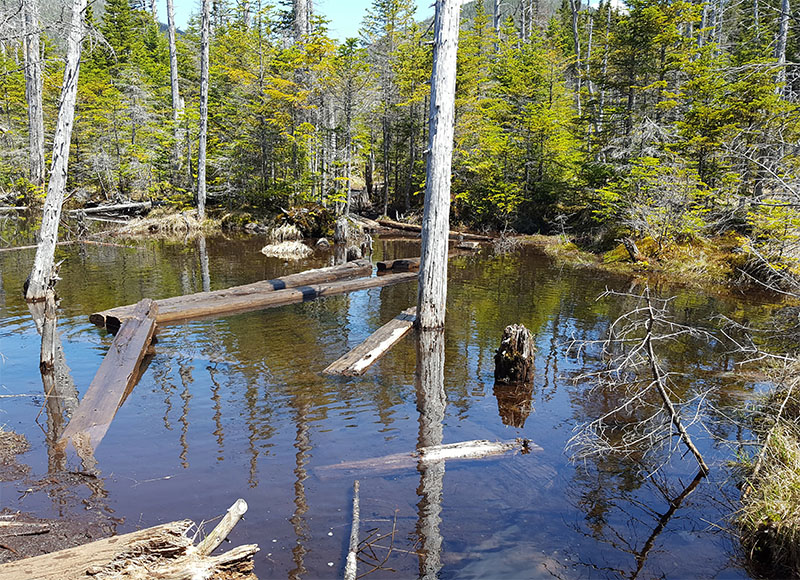 This section of trail, photographed in the spring when snow melt raises water levels, has become even more flooded due
This section of trail, photographed in the spring when snow melt raises water levels, has become even more flooded due
to a beaver dam. When this photo was taken, the water was hip deep. Hikers are left to their own devices to cross.
The bog bridging in this area desperately needs some trail maintenance attention. Photo credit: Charlotte Staats
Achieving Balance
While on trail crew, I came to realize that the Adirondacks require balance and holistic solutions, both on and off the trails. The Adirondack Park is unique and multifaceted, and solutions to Adirondack issues must be the same. Solutions that address overuse in the High Peaks region will hopefully take into consideration the vast number of trails that are slowly being reclaimed by the forest. Trail crews work hard to build trail infrastructure that will mitigate erosion and overuse, but it takes people and time to build these structures. There aren’t many trail crews in the Adirondacks, and there are definitely not enough to keep up with the hundreds of miles of trails requiring maintenance. More backcountry and front-country infrastructure is needed to ensure that people can safely, respectfully, and sustainably access and recreate in the Adirondack Park. What I’ve seen from my time spent working throughout the Adirondack Park is this: there are too many people coming to only a small portion of the Park. The Adirondack Park offers something for everyone in its six-million acres. Let’s work to expand everyone’s interest to include the rest of the Adirondacks. Not only will the Forest Preserve lands benefit from a broader and more widespread visitor-ship, but so will small communities throughout the Park.
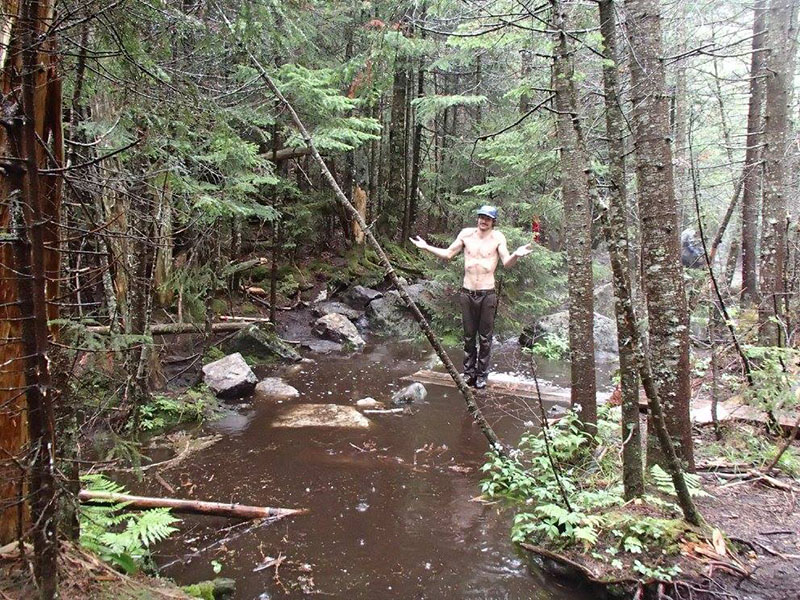 A trail crew worker standing at his work site. This section required drainage work, trail hardening and step stones to cross
A trail crew worker standing at his work site. This section required drainage work, trail hardening and step stones to cross
the seasonal stream. This section of trail floods often after hard rainstorms. The work done through this section of trail has
helped make it easier to hike without soaking your boots. Photo credit: Alisa Fersch
Solutions that will help the Adirondacks need to be expanded to include outreach and education efforts in every step of a trip to the Adirondacks. Educational opportunities need to be readily available from the moment someone starts planning a trip in their home to the trip’s zenith. There are opportunities for outreach and education already, but we need to broaden and expand them.
The only way these solutions are going to be possible is through funding and additional personnel, either from the state or other partners. Education, outreach and additional infrastructure all need to be funded and workers are needed to accomplish those tasks.
My Last Lesson
After spending collectively almost two entire years in the woods, I’ve come to realize that there’s beauty to be found on every foot of trail in the Adirondacks. Many trail maintenance projects are far from the summit of a peak. They are often on sections of trail that are most often passed by without a second thought. When you spend days working on the same section of trail, the beauty in that spot begins to reveal itself: picturesque tufts of club moss glistening in morning dew, the mist that floats through the evergreen forests after a rainstorm, the rhythmic squeaking in the evening of white-spotted sawyers.
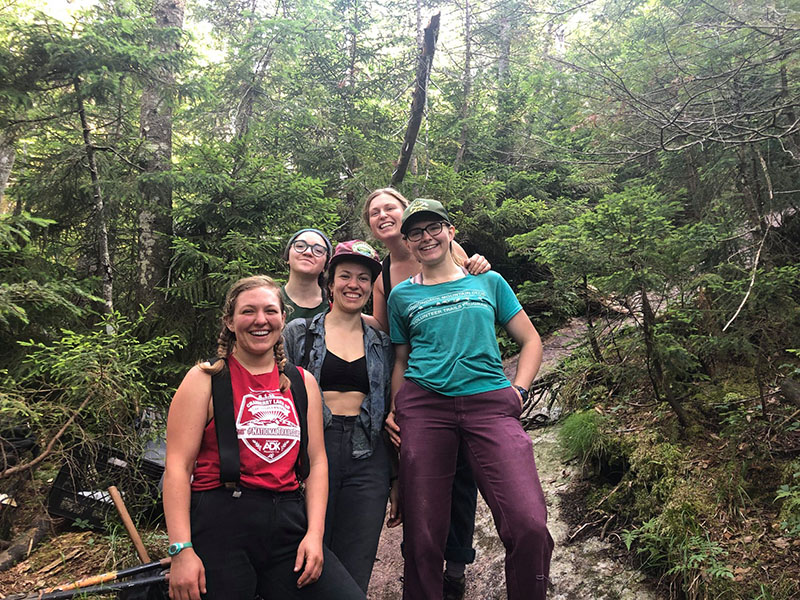 All smiles on the trail. Work had not yet begun at this site. I have worked on this trail a couple weeks during three separate
All smiles on the trail. Work had not yet begun at this site. I have worked on this trail a couple weeks during three separate
summer seasons. During breaks, I could enjoy soaking in the beauty of the wilderness around me.
Photo credit: Maddie Phaneuf
I’ve hiked the trail to Marcy Dam more times than I can count, but it’s still beautiful and changing. There is always something new to see if you keep your eyes open and are looking around. I don’t have to focus on summiting the peaks that people keep posting about on social media. If you’re looking for solitude or to reconnect with nature, you don’t have to do it from the top of a High Peak. Enormous yellow birches await in the flat forests of the Ha-Da-Ron-Dah Wilderness, otters and beavers play in the wilderness waters. There’s more than a life time’s worth of exploring in all six-million acres of the Adirondack Park.
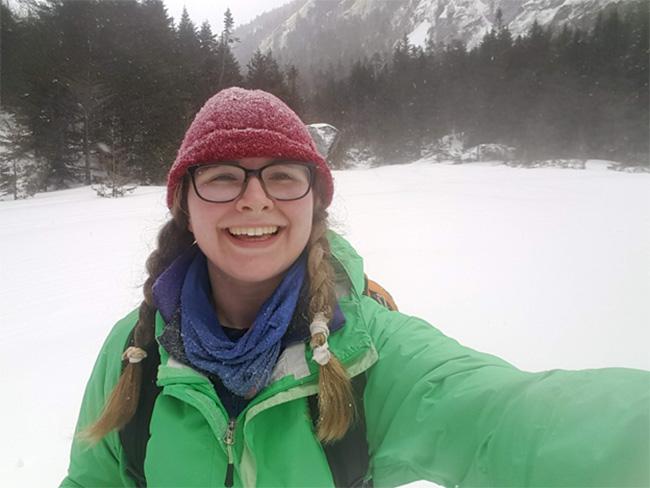
Charlotte Staats is the Adirondack Council’s Clarence Petty Advocacy Intern for the 2020 legislative session. She grew up in Westport, New York, and graduated from Clarkson University in 2017 with a Bachelor of Science in Environmental Science and Policy. For the past five years, Charlotte worked on a professional trail crew, building and maintaining hiking, skiing, mountain biking, and snowshoe trails throughout the Adirondack Park.




